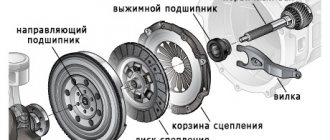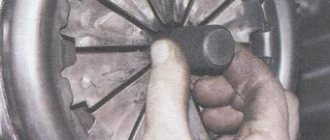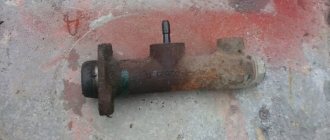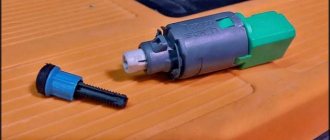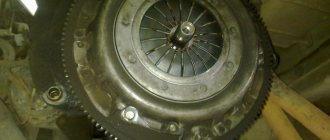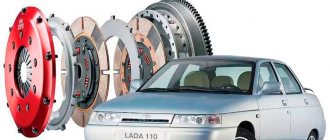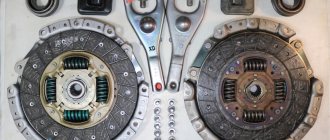The main purpose of the clutch mechanism in an ordinary car is the operation of combining the crankshaft with the gearbox, followed by the transmission of torque from the propulsion system to the wheel set. Timely adjustment of such equipment reduces the risk of wear of all transmission parts, and, in particular, the release disk.
A VAZ 2107 car, the driver of which did not take care of the settings, may behave unpredictably: slip when using the gearbox or even refuse to respond to steering commands.
DEVICE OF THE CLUTCH MECHANISM VAZ 2107
The VAZ 2107 clutch is a rather complex mechanism consisting of several dozen elements. The reasons for its malfunction can be very different. However, they can all be divided into two groups:
- Defects in the clutch mechanism itself. These include malfunctions of the driven part of the clutch, pressure device, basket, flywheel, and clutch fork.
- Defects in the hydraulic drive of the clutch mechanism. They can be caused by leakage of the working fluid, the formation of an air lock in it, as well as malfunctions of the main or working cylinders (MCC and RCC) and the pedal mechanism.
The clutch, like any other car part, has a limited service life. First of all, it depends on the skill of the driver, and therefore is not regulated by the manufacturer. To increase the service life of the clutch, it is necessary to adjust it in time, monitor the level of working fluid, avoid off-road driving, and learn the skills of using the clutch correctly.
It must be remembered that in addition, the clutch is a safety device that protects the transmission from serious damage when the rear wheels are blocked by various obstacles. The car is stuck in a quagmire, the drive wheels are stuck, the engine power is enough to turn the stuck tires. In this case, the clutch will begin to slip, protecting the gearbox, cardan and rear axle from damage. Yes, the driven disc linings will burn out. Yes, the clutch will overheat, which can cause the steel flats to warp or weaken the spring plates. But more expensive units will be protected from breakdowns.
Classic VAZ models have a dry, permanently closed single-plate clutch. It includes two main elements:
- Leading part. It consists of a driven disk, the splined part of which transmits rotation to the gearbox due to friction between the friction linings and the surfaces of the flywheel and pressure plate.
- Non-removable drive unit (basket). The basket is attached to the flywheel and consists of a pressure plate and a diaphragm pressure spring.
Classic VAZ models use a single-disc dry, permanently closed clutch: 1 - flywheel;
2 — clutch driven disc; 3 — clutch basket; 4 — release bearing with clutch; 5 — hydraulic clutch reservoir; 6 - hose; 7 — master cylinder of the hydraulic clutch release; 8 — servo spring of the clutch pedal; 9 — clutch pedal return spring; 10 — clutch pedal travel limit screw; 11 — clutch pedal; 12 — hydraulic clutch release pipeline; 13 — ball joint fork; 14 — clutch release fork; 15 — release spring for clutch release fork; 16 — hose; 17 — working cylinder of the hydraulic clutch release; 18 — clutch bleeder fitting The clutch mechanism must be reliable, durable, and capable of damping fluctuations in engine torque. The clutch has a hydraulic drive consisting of:
- clutch master cylinder;
- clutch slave cylinder;
- clutch on/off forks;
- release bearing;
- foot pedal.
If the setting didn't help
You can adjust the optimal pedal travel by adjusting not only the master cylinder, but also the clutch slave cylinder.
To do this, disconnect the tension spring from the clutch release fork. We need this in order to reduce resistance during adjustment. Next, set the ruler so that it rests on the end of the element. Then press the clutch fork all the way with your hand. We fix it in the squeezed position. We remember how the fork is positioned relative to our ruler and measure the free play.
Let's move on to setting up the working cylinder itself. Since the element is located under the bottom, there may be traces of dirt and corrosion on it. To unscrew the required nut, use VD-40 or its equivalent from. You need to unscrew it with two keys.
We hold the adjusting bolt with one, and loosen the locknut of the clutch slave cylinder with the second. We fix the pusher so that it does not turn. We adjust the free movement of the element. Tighten the locknut and install the spring in place. We check the operation of the system. Free play should return to normal.
The VAZ-2106 clutch pedal free play is adjusted if the value exceeds 2 mm. If the pedal has a very long travel and there are dips, then it is necessary to correct the position. Until you adjust the mechanism, the clutch will not function properly.
If there is play in the mechanism, the driven and driving disks will not be able to disconnect from each other. If you notice that the pedal has sank, you will need to reset the free play. Set the gap between the clutch fork and the slave cylinder. The play should not exceed 5 mm. To evaluate the free play of the fork located near the gearbox, you need to move it in different directions and measure the displacement distance.
On the subject: Rating of crossovers by reliability: list, manufacturers, test drives, top of the best
A working cylinder is installed near the gearbox, on which there should be no brake fluid leaks. If the boot is damaged or the tightness of all connections is broken, the mechanism must be replaced.
If adjusting the VAZ-2106 clutch pedal did not bring the desired effect, then the reason for the large free play lies in the basket and disc. It is advisable to install a new kit, which includes:
- Basket (drive disc is mounted directly on the crankshaft flywheel).
- Driven disk (located inside the basket, connected to the gearbox input shaft by a splined connection).
- Release bearing (mounted on the input shaft and driven by the fork).
- Bolts and lock washers.
On the topic: Taganrog Construction College: directions, faculties, form of education. Information for students and applicants
After installing all the new elements, it is necessary to adjust the VAZ-2106 clutch and make sure that the brake fluid in the system is of good quality and does not contain any impurities. Try to change the fluid at least once every two years.
Pumping technique
It is advisable to carry out the work on an overpass or inspection hole; in extreme cases, the machine should be raised on supports. Further actions are carried out according to transitions:
- Pour new fluid into the clutch reservoir.
- Place one end of the hose onto the working cylinder fitting and lower the other end into a container.
- Ask an assistant to press the clutch pedal 5-6 times and hold it pressed.
- Loosen the fitting on the cylinder with a “8” wrench and release the liquid with air into the container, then tighten the fitting and ask to release the pedal.
- If necessary, add liquid to the tank and repeat the operation until there are no air bubbles in the liquid.
During pumping, do not allow the liquid level in the tank to drop below 15 mm, and top it up in a timely manner. Finally, you need to check the functionality of the coupling:
- Start the car and put the car in reverse gear; the appearance of jamming or extraneous noise is unacceptable.
- Check the gear shift while driving; if acceleration and shifting occur without jerking or extraneous noise, then the clutch control system is configured normally.
When replacing the clutch basket due to wear, it is sometimes necessary to check the parallelism of the heel and the plane of the flywheel. In old cars and in Moskvich cars, this was done by adjusting the basket legs. In the Fiat engine they were replaced by diaphragm springs, so there was no need for adjustments.
REASONS FOR REPLACING AND ADJUSTING THE VAZ 2107 CLUTCH
Replacing a VAZ 2107 clutch is a rather labor-intensive and expensive process. Therefore, before replacing, you should consider adjusting the mechanism.
REPLACING THE CLUTCH
To install a new clutch, you will need an inspection hole, overpass or lift. It is important to detect in time the signs indicating the need to replace the clutch (it is impossible to replace it on the road), and take the car to a garage or car service center. Driving with a faulty clutch is very dangerous - you can get into an accident when crossing a railway crossing or a main road.
The VAZ 2107 clutch cannot be repaired, but is replaced as a kit, which includes a basket, driven disc and release bearing
The entire VAZ 2107 clutch is replaced, so auto shops sell a kit consisting of a driven disc, a basket and a release bearing. You should consider replacing the clutch in the following cases:
- the car climbs heavily uphill when the accelerator pedal is pressed all the way down, and you can smell a burning smell - these are signs of slipping of the driven part of the clutch;
- when the clutch is disengaged, noises appear in the area of the flywheel housing - this indicates a malfunction of the release bearing;
- when starting the car, it is difficult to engage first gear (the gearbox “growls”) - this is a sign that the clutch is not completely disengaged (the clutch is moving);
- when accelerating, the car begins to twitch, rattling sounds are heard - the reason for this is usually broken damper springs or loose sockets for them on the driven disk, deformation of segments or loose rivets on the hub.
Any noise, vibration, or whistle in the clutch area requires more detailed diagnostics and diagnosis.
ADJUSTING THE CLUTCH
If the clutch pedal becomes too soft, falls down, and does not return to its original position, then most likely air has entered the system or the hydraulic drive adjustments have been disrupted. Clutch slipping after prolonged use usually indicates a failure of the clutch. It will probably have to be changed.
When adjusting the hydraulic clutch of a VAZ 2107, the regulated values of the gaps and the pedal stroke are set
If the clutch drives, that is, shifts gears with difficulty, in about half of the cases the reason is a discrepancy with the required values:
- play between the rod and the piston in the working cylinder;
- clearance between the release bearing and the fifth basket;
- free and working travel of the foot pedal.
Clutch “diseases” and where they come from
There are a large number of malfunctions that the owner of a VAZ-2110 may encounter. Among the most common signs of a problem are the following:
- Slipping and incomplete engagement, which causes noticeable difficulties when changing gears, especially when trying to shift to reverse or first.
- If you press the pedal sharply, the engine speed increases, but the acceleration is not noticeable. This situation is especially dangerous during overtaking, when a driver who has no idea that he has a broken clutch tries to pass the cars in front of him.
- When you try to disengage the clutch, it does not disengage completely, and excessive noise (crunching) occurs when shifting gears.
- During the start the car breaks down.
- While driving, the car constantly makes sounds that are uncharacteristic of normal operation, which further intensify after engaging the clutch.
Clutch slipping
In the vast majority of cases this is due to the following reasons:
- oiling of the linings, pressure plate or flywheel;
- excessive wear or burnout of friction linings;
- drive damage.
To eliminate this problem, you should thoroughly rinse the oily parts with gasoline or white alcohol, and then identify and eliminate the cause of excessive oiling.
If you have a damaged drive, you should try to eliminate the reason why it is sticking, or replace it completely.
Jerks at start
This problem is characterized by sudden jerks when trying to move the car. Most often, this problem occurs due to the drive cable being stuck, which will require you to treat it with engine oil or replace it with a new one.
If the HP hub jams on the splines, they should be completely cleaned of dirt or any minor damage.
Also, replacement of the HP will be required if it is deformed and the linings are weakened.
There is a noise when the clutch is engaged
In addition, in some cases, the cause of the malfunction is loosening of the FN fastening or deformation of the HP, which can be solved by replacing components.
There is increased noise
If there is a characteristic noise when trying to engage the clutch, check the bearing lubrication and wear. In any case, the most optimal solution to the problem would be to completely replace the bearing.
Clutch not fully disengaging
Another common problem, which is characterized by difficulty shifting gears and the presence of characteristic noise, although the gearbox seems to be in good working order. If the adjustment was performed incorrectly, this procedure should be repeated, and then replace the deformed fork.
If the cable gets stuck, it must be lubricated with engine oil or some other product. If this does not help, it is replaced.
If the HP is warped or the FN rivets are weakened, the only correct solution would be to completely replace the disk.
Adjusting the clutch on a VAZ 2107: Diagnostics and step-by-step instructions
How to adjust the clutch on a VAZ 2107 with your own hands, without special experience. Despite the fact that domestic models of some brands are fading into oblivion, creations of the Soviet automobile industry are still roaming the roads.
Considering the age of the machines, they, more than anyone else, need systematic repairs to maintain working condition. Repairing equipment with such mileage in modern car repair shops is not always justified from a financial point of view.
Therefore, many car owners strive to fix breakdowns on their own, on their own. They don’t always succeed, but articles of this kind – recommendations like this one – come to their aid.
Clutch diagnostics
So, before you start repairing, check to see if the part needs to be adjusted enough. For example, frequent problems arise with the clutch, or more precisely with the release plate. Owners first of all blame the “basket”, they say, it has burned out, when you often keep the pedal in the active position in traffic jams.
In fact, it turns out that this is not at all the case, you need to tighten the clutch cable a little and everything will work out. At the same time, the need to replace the unit as a whole simply disappeared. Proper operating conditions for the clutch will ensure a service life of at least 70 – 90 thousand km.
Facts of a maximum mileage of 390,000 km have been recorded, however, this happened on the “famous” troika manufactured in those days. Some manage to “kill” the basket and disc within 50–60 thousand runs.
When is it necessary to change?
The clutch system allows the car to move off smoothly, removing the load from the engine, which reduces wear on its parts and extends its service life. Overloads are caused by an inertial moment formed during the rotation of parts of the power unit if the crankshaft speed has sharply decreased.
VAZ 2107 assembly diagram
There is no specific time frame for replacing the unit, since the service life of this device mainly depends on operating conditions and the driver’s driving style. It is recommended to diagnose the device after 80 thousand km.
How to adjust the clutch on a VAZ 2107
First, we need to make sure that such a procedure is necessary.
What tools will be needed for repairs?
We check in advance the availability of automotive tools needed for repairs, such as:
- stationary set of keys;
- pliers;
- extension cord and additional lighting if work will take place at night or in low light conditions;
- new cable, cuffs, boots, other parts of original production from the manufacturer.
Step-by-step instruction
1 The beginning of it all - the slave master cylinder
Most common breakdowns
Every car owner of domestic brands is familiar with the concept of slipping and dragging, this applies to the clutch.
- in the first case: when the pedal is fully lowered to the bottom position, the clutch disc itself slips a little, thereby not providing the transmission with the required amount of power;
- in the second: the clutch pedal, which is completely flooded down, cannot move the basket away from the flywheel, because of this the car moves even when the rocker is in the neutral position. This situation is extremely negatively reflected in the control process itself, since the speeds will turn on either too early or too late.
How to adjust pedal free play on Nissan cars
As the clutch parts (disc and basket) wear out, the free play changes, and therefore requires adjustment. On a Nissan car, the clutch drive can be different - mechanical and hydraulic, so the PS adjustment is carried out differently. For example, a cable is installed on Nissan Sunny cars in bodies N13 and N14, Almera, Primera; Qashqai, Tiida, Almera Classic, Note, Maxima cars are equipped with a hydraulic drive.
However, a hydraulic drive can also be installed on Sunny or Primera, much depends on the type of engine and model generation. Nissan “hydraulics” are usually equipped with cars with more powerful internal combustion engines (2.0/ 2.5/ 3.0 l); cars with 1.4/ 1.5/ 1.6 l engines come with a clutch cable.
On a Nissan N14 car, the cable is adjusted in the area of the clutch fork; the adjustment mechanism is located at the very end of the cable.
The same cable is installed on the Almera, and in order to shorten it when the DS linings are worn out, car owners add washers, and in this case it is no longer secured with a lock nut.
Like on a Hyundai car, the GCS on Nissans is located next to the pedal; these parts are connected to each other by a rod on which there is an adjustment.
To adjust the free play of the PS on the Nissan Almera N16 ( />
Second stage of clutch adjustment
As mentioned earlier, the entire adjustment process consists of two stages, the first was described earlier, we are starting the second now.
- Using pliers, remove the return spring from the pusher. This is necessary for the convenience of setting up and adjusting, as well as during major repairs or complete replacement of the unit;
- use a key set to “19” to unscrew the lock nut;
- with the second wrench set to “14” we tighten the nut a few turns forward or backward, depending on what purpose you are pursuing;
- Check the pedal free play size. If necessary, we bring it to the required standards;
- fix the nut and tighten it with a little force.
What's the best way to change?
It is best to replace the device by placing the car on a lift, overpass or inspection groove. If this is not possible, then you can raise the car using a jack to get to the unit from below. For safety, you need to fix the wheels so that the car does not roll or put on the hand brake.
Tools
To carry out repairs, you need to prepare the appropriate tools:
- set of keys;
- screwdrivers;
- pliers;
- clean rags;
- jack;
- new consumables.
When choosing a new replacement kit, you need to buy original parts, preferably assembled.
Stages
The replacement procedure consists of the following steps:
- Having opened the hood, first of all you need to turn off the power to the car. To do this, you need to remove the negative terminal from the battery.
Engine compartment of VAZ 2107
Removing disks from a node
Installing a new drive
After the repair is completed, the vehicle system should be checked for functionality.
Important Tips and Recommendations
- carry out technical inspection of parts in a timely manner;
- Never keep the pedal depressed for a long time while the gear is engaged. Inexperienced owners often suffer from this. It is in such cases that the clutch fails at a rapid pace;
- Before each departure, carry out a light inspection of the engine compartment;
- Don't pedal too fast or too slow. In the first case, this will lead to a break, in the second to combustion;
- purchase only original spare parts, no fakes or cheap analogues;
- If you are in doubt about the correct installation, read the operating instructions for the equipment.
It would be wrong to consider that this procedure is completely over. Operation in motion should be checked carefully. To do this, we start the vehicle, remove it from the handbrake, depress the pedal, and begin to move away.
Features of clutch in automatic and manual transmission
The clutch can be single or double disc. Depending on the principle of operation, it is divided into “wet” (in the presence of oil or lubricant) and “dry”. So, automatic transmissions most often have a multi-plate wet clutch.
Due to the absence of a pedal, the force in the automatic transmission is transmitted by a servo drive, or actuator. The entire installation is controlled using a control unit and a hydraulic distributor. In a manual transmission, two types of clutch operate alternately. Actuators differ in their operating principle:
- Electric (otherwise known as a stepper motor). The control unit constantly receives data on engine speed, and at a certain speed the servo drive receives a corresponding signal. The transmission mechanism disconnects the crankshaft and input shaft.
- Hydraulic – hydraulic cylinder. In the drive mechanism, the oil pump transmits pressure to the distributor, under certain conditions to the servo drive. After changing gears, the pump force decreases.
How to adjust the clutch on a VAZ 2107
A correctly adjusted VAZ 2107 clutch ensures normal operation of the vehicle and long-term operation of the machine’s components and parts.
It is recommended to check the correctness of the adjustment at every vehicle maintenance. During operation, incorrect adjustment can result in two types of malfunctions:
- The clutch slips - when the pedal is fully released, the disc slips and does not transmit the full amount of engine power to the transmission;
- The clutch drives - when the pedal is fully depressed, the disc does not move away from the flywheel, which does not allow normal gear changes and makes the car move when it is not needed.
In addition, the clutch may engage too early or late, making it difficult to control the vehicle.
The adjustment process itself consists of two parts. The first is carried out in the cabin, the second - under the bottom of the VAZ 2107, from the inspection hole. Tools you will need:
- Key for 8 or 10, depending on the model of the clutch slave cylinder;
- Open-end wrench 13;
- Open-end wrench 17.
The first adjustment involves setting the clutch pedal travel. It is performed from the interior, under the steering column. To limit the full stroke, use a special adjusting screw secured with a lock nut. By tightening or unscrewing it, we achieve normal pedal travel, which should be approximately 140 mm. Usually there is no need to adjust the full stroke; it is set from the factory and is changed very rarely.
The second part of the adjustment is to set the pedal free play. In normal mode it should be 30-35 mm. However, some car enthusiasts adjust the freewheel to suit their individual habits and preferences. This approach is quite acceptable provided that it does not affect the performance and durability of the parts of the VAZ 2107 car.
So, to check and adjust, we go down into the inspection hole. The clearance is checked by pulling the fork away from the pusher.
The free play distance should be 4-5 mm. If the gap differs significantly from the standard, it must be adjusted. For this:
- Remove the spring that pulls the clutch fork to its original position;
- Loosen the locknut on the pusher;
- Holding the pusher with a 8 (10) wrench, screw or twist the thrust nut until the required clearance is achieved;
- Fix the thrust nut with a locknut;
- Checking the gap;
- We install the spring in place.
At this point the adjustment procedure can be considered complete. However, in order to ensure that the result obtained is correct, it is necessary to check the clutch in action. To do this, start the car, engage the gear and gradually begin to release the pedal. When adjusted correctly, the car should move off at approximately half the pedal stroke. Adjustment is allowed, including the clutch lower or higher, but engagement at the very top or bottom is unacceptable, as there is a risk of the above malfunctions occurring.
Tools and materials
In order to cope with the operations of adjusting the transmission on a VAZ 2107 with dignity and quality, the driver will need the following tools:
- set of wrenches;
- bottle with hydraulic fluid;
- flat-head screwdriver;
- container for draining waste liquid;
- a small amount of rags;
- ruler or tape measure.
A similar set is probably present in every person who, to one degree or another, has encountered procedures for repairing various vehicles.
How to adjust the clutch of a VAZ-2107
During vehicle operation, an incorrectly adjusted clutch is expressed as follows:
- The clutch drives. When the clutch pedal is fully depressed, the disc does not move away from the flywheel, making it impossible to change gears normally. Thus, the car can start moving even when it is not necessary.
- The clutch is slipping. When the clutch pedal is fully released, the disc begins to slip. As a result, it does not transfer all the engine power to the transmission in full.
In addition, problems with the clutch sometimes result in it setting too early or, conversely, too late. As a result, driving may become significantly more difficult.
How to check pedal free play
Clutch free play is the period of pedal movement from the moment it is pressed to the moment it is activated. You can notice that when you press the clutch, at first there is no proper resistance, and somewhere in the middle of the stroke an increase in rigidity appears.
If the vehicle starts moving immediately when you touch the pedal, then it is better to make the adjustment urgently, since there is no free play at all. Otherwise, the pedal can be pressed to the floor, but the car does not move.
Free play is required for all manual transmissions, since it indicates clearance between the fork, bearing and disc levers and prevents constant contact of the bearing with other elements of the mechanism. It is important to monitor the size of the free play, because if it is too large, full pressure will not be enough to transmit sufficient force to squeeze the drive disk.
A separate reason for checking free play is noise and jerking when interacting with the clutch. You can measure this indicator yourself using a ruler.
It is necessary to measure the perpendicular distance from the floor to the pressure pad. Next, when you gently press the pedal, you should measure the stroke until resistance first appears. The result must be checked against the data in the vehicle's operating manual.
The general average clutch stroke for a car is 160 mm. It is recommended to carry out preventive maintenance and adjustment every 20 thousand km.

